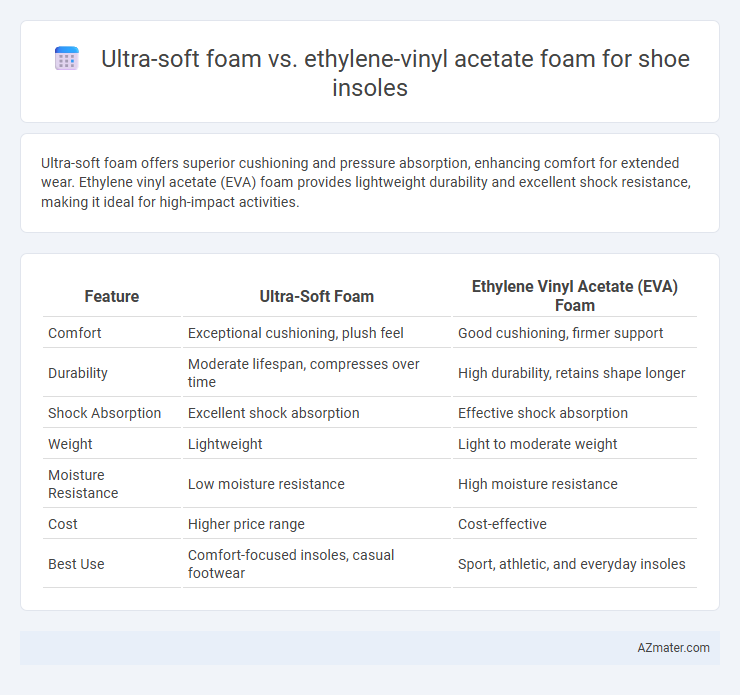Ultra-soft foam offers superior cushioning and pressure absorption, enhancing comfort for extended wear. Ethylene vinyl acetate (EVA) foam provides lightweight durability and excellent shock resistance, making it ideal for high-impact activities.
Table of Comparison
| Feature | Ultra-Soft Foam | Ethylene Vinyl Acetate (EVA) Foam |
|---|---|---|
| Comfort | Exceptional cushioning, plush feel | Good cushioning, firmer support |
| Durability | Moderate lifespan, compresses over time | High durability, retains shape longer |
| Shock Absorption | Excellent shock absorption | Effective shock absorption |
| Weight | Lightweight | Light to moderate weight |
| Moisture Resistance | Low moisture resistance | High moisture resistance |
| Cost | Higher price range | Cost-effective |
| Best Use | Comfort-focused insoles, casual footwear | Sport, athletic, and everyday insoles |
Introduction to Shoe Insole Materials
Ultra-soft foam and Ethylene Vinyl Acetate (EVA) foam are popular materials used in shoe insoles, each offering unique benefits for comfort and support. Ultra-soft foam provides exceptional cushioning with a plush, adaptive feel, ideal for reducing foot fatigue during extended wear. EVA foam delivers durable, lightweight shock absorption and flexibility, making it a preferred choice for athletic and everyday footwear requiring balanced performance and comfort.
What is Ultra-Soft Foam?
Ultra-soft foam is a lightweight, highly flexible material used in shoe insoles to provide superior cushioning and shock absorption, enhancing overall comfort during prolonged wear. Its cellular structure allows for excellent breathability and pressure distribution, reducing foot fatigue and preventing discomfort. Compared to ethylene vinyl acetate (EVA) foam, ultra-soft foam often offers a softer feel and increased adaptability to the foot's shape, making it ideal for sensitive or high-impact activities.
What is Ethylene Vinyl Acetate (EVA) Foam?
Ethylene Vinyl Acetate (EVA) foam is a lightweight, flexible material commonly used in shoe insoles for its excellent shock absorption and cushioning properties. EVA foam provides durable support while maintaining softness, which helps reduce foot fatigue during extended wear. Compared to ultra-soft foam, EVA offers a better balance of comfort and resilience, making it ideal for athletic and casual footwear.
Comfort Comparison: Ultra-Soft Foam vs EVA Foam
Ultra-soft foam insoles provide superior cushioning with enhanced pressure distribution, making them ideal for prolonged wear and sensitive feet. Ethylene vinyl acetate (EVA) foam offers firmer support and excellent shock absorption, promoting stability during high-impact activities. Comfort preferences vary, as ultra-soft foam prioritizes plush softness, while EVA foam balances comfort with structural durability.
Durability and Longevity
Ultra-soft foam offers excellent initial comfort but tends to compress and lose its cushioning properties faster than Ethylene Vinyl Acetate (EVA) foam. EVA foam is renowned for its durability, maintaining structural integrity and shock absorption over extended periods of use. Shoes with EVA foam insoles provide better longevity, making them ideal for high-impact activities and long-term wear.
Cushioning and Shock Absorption
Ultra-soft foam insoles provide exceptional cushioning by conforming closely to the foot's contours, enhancing comfort and reducing pressure points. Ethylene vinyl acetate (EVA) foam excels in shock absorption due to its lightweight, resilient properties that dissipate impact forces effectively during walking or running. Choosing between these materials depends on whether the priority is plush comfort or durable impact resistance for optimal foot support.
Breathability and Moisture Control
Ultra-soft foam insoles offer moderate breathability but tend to retain moisture, which can reduce overall comfort during extended wear. Ethylene vinyl acetate (EVA) foam provides superior breathability due to its open-cell structure, enhancing air circulation and promoting faster moisture evaporation. This makes EVA foam insoles more effective at controlling moisture and maintaining a dry, comfortable environment inside the shoe.
Support and Foot Health Benefits
Ultra-soft foam insoles offer superior cushioning that enhances comfort but may lack the structured support needed for long-term foot health. Ethylene vinyl acetate (EVA) foam provides a balance of shock absorption and firm arch support, promoting better alignment and reducing strain on ligaments and tendons. Choosing EVA foam insoles can improve foot stability and prevent common issues such as plantar fasciitis and overpronation.
Cost Effectiveness and Affordability
Ultra-soft foam offers superior cushioning and comfort but tends to be more expensive due to advanced materials and manufacturing processes. Ethylene vinyl acetate (EVA) foam provides a balance between cost effectiveness and durability, making it a popular affordable choice for mass-produced shoe insoles. EVA foam's lightweight and shock-absorbing properties deliver acceptable comfort at a lower price point, enhancing its attractiveness for budget-conscious consumers.
Best Use Cases and Recommendations
Ultra-soft foam insoles excel in providing maximum cushioning and comfort, making them ideal for casual wear and activities requiring prolonged standing. Ethylene vinyl acetate (EVA) foam offers superior shock absorption and durability, preferred for athletic and high-impact activities such as running or hiking. For optimal performance, choose ultra-soft foam insoles for everyday comfort and EVA foam insoles when enhanced support and resilience are necessary.

Infographic: Ultra-soft foam vs Ethylene vinyl acetate foam for Shoe insole
 azmater.com
azmater.com